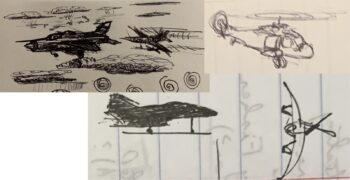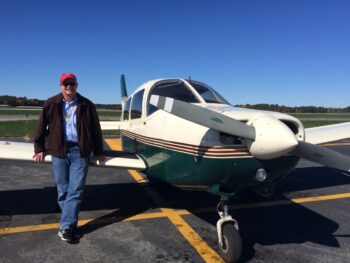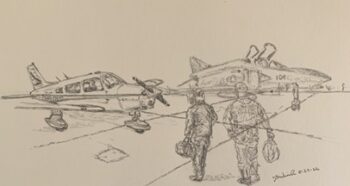As long as I can remember, I’ve been fascinated by airplanes. I’ve watched them, ridden in them, doodled/drawn/painted them, and read about them. I’ve visited aviation museums, been to air shows, and spent most of my professional life often involved in some way with airplanes and flight. I love the sound of jet noise, the smell of jet exhaust, that peculiar fake leather/hydraulic scent an airplane has, and the way an airplane looks. When an airplane flies overhead, I invariably look up—I can’t help it.

But until relatively recently, I never actually flew an airplane myself. Unlike many of my USAF and Practical Aero colleagues, I am not a professional pilot, although at times I have been a “professional passenger.”
Where does this fascination (fixation? obsession?) come from? Some of it is probably instinctive in the sense that we humans naturally look to the skies and envy those marvelous creatures we call birds. But, for me, a lot of it had to do with my dad, who was a naval aviator. He flew fighters starting in the early 50s and flew right up until he retired from the Navy in the early 80s. I have his logbooks—his earliest entries include Hellcat night fighter sorties and at the end his logs show F-18 hours. When he had access to a Cessna or Piper, he took me up with him. When I was little, on weekends, he sometimes took me with him to his office, where I read Aviation Week or Naval Aviation News while he caught up on work. Then we’d go look at some airplanes in a hangar nearby. So, from a young age, I (like many young kids) wanted to be like him, a pilot.
But there was a rub. Fate did not give me his eagle eyes. In fact, I got the complete opposite. In 3rd grade, after having trouble seeing the blackboard, I started wearing glasses. Thick, coke bottle glasses. That’s what you wear when you are 20/400-nearsighted. Thick coke bottle glasses and a career as a pilot, especially a military pilot, don’t go together very well.
I suppose I could have still taken flying lessons on my own, but they were expensive, and I moved a lot as a kid, so, as things like that sometimes go, with one brief exception, I never did. I went to college, got married, joined the Air Force, started a family, and moved a lot more. But my fascination with airplanes never left me and occasionally, in the right place at the right time, I was able to indulge in that fascination.
My first assignment as an Air Force officer was to Eglin AFB, where I was a munitions test engineer. I had a flight line badge and was often out on the line observing test munitions being loaded on aircraft. Eglin was great for an airplane nut. My test wing had F-4s, F-16s, F-15s, F-111s, A-10s, T-38s, and Huey helicopters. There was also an F-15 wing across the base. Something was always in the air! On the test range, I would sometimes get buzzed by a fighter; I remember an F-105 one time and an A-7 another. I often saw AC-130 gunships on the next range over firing against practice targets. My boss was one of the Wing’s Huey pilots and one day he took several of us Lieutenants flying at low level over the Eglin range. Like I said, it was great.
A couple of assignments later, I was teaching at the USAF Academy and one of my fellow instructors was an instructor glider pilot. So, looking for an affordable way to get in the air, I signed up to take soaring lessons from him. After many (very short) flights, I solo’d. But as I was getting close to my check-ride I received orders to Southern California to start graduate school. That ended my glider flying. But I never passed up on a museum or air show in LA and flight and airplanes were constantly in my thoughts.
After graduate school, I was stationed at Kirtland AFB, NM, where I was lucky enough to be assigned as a flight test engineer on a KC-135—we flew various kinds of research and test missions and, for the only time in my career, I got an inkling of what military flying was like (including wearing my own flight suit!). I went weightless twice (inadvertently), rode to 50,000 ft on one of my test missions, and saw the aurora while flying on a night mission in the winter along the Canadian border.
One of my last assignments in my Air Force career was Director of Air Vehicles at the Air Force Research Lab’s Air Vehicles Directorate. I was like a kid in a candy store: wind tunnels, structures test rigs, flight simulators, and a lot of people who thought airplanes were cool, especially airplanes of the future. One of my personal rules was to never meet people in my office—I always went to them, which was a great way to get out and about and see all the cool stuff we were doing. For example, we had a generic airplane cockpit mounted on the end of a long, hydraulically controlled arm. It could simulate different airplanes. One day I landed an advanced bomber (I also “crashed” it a couple of times). At the end of the “flight” a mechanical voice came on and said “Please deposit…(pause)… 25 cents.”
After I retired from the USAF, I joined Aurora Flight Sciences to be a group leader and program manager. Aurora was great, because it was filled with people who were passionate about airplanes, it had a couple of hangars that had actual airplanes in them, and those airplanes flew often. As a program manager, I was frequently out at our test site, which was a small grass strip west of Washington, DC, while our Huey conducted autonomous approaches to landings.
But something was missing. I was happy to be around airplanes, to work with people designing and developing them, and to think about them as part of my job. But I still wasn’t a pilot like my dad was. A piece was missing.
So, at the age of 55, I decided it was time to get my pilot’s license.
I went to East Coast Aero Club at Hanscom Field outside Boston, where I live, and arranged for an orientation ride. After a short discussion and a preflight, my instructor put me in the left seat (!!) and, on my very first ride in that seat, he let me take off (!!!). I remember getting a little choked up, hoping Dad was up there watching. But I immediately said to myself, “Knock it off and FLY THE AIRPLANE!”

My training was somewhat erratic. At that time, I was traveling a lot for work and in the middle of training, I had to take a break when my mom got sick and passed away. I also went through four instructors; each one would teach me for a bit, then get hired by the airlines and leave. Then I’d have to get a new instructor and go through what I call the “mating dance” while we got acquainted with each other. My last instructor, a woman a little older than me, was tough and exacting. I had a hard time with landings, judging the flare, managing the crosswind, and staying on centerline. At one point, after a particularly rough landing, she literally threw up her hands and said, “I don’t know what I’m going to do with you!” But, she got me across the finish line and one day, as a newly minted private pilot, I happened to walk into the club office, where she was standing, and she exclaimed, “There’s my favorite student!” That made my day.
By that time, I was approaching 60 and was content to just fly for fun. I didn’t really go to a lot of exciting places, but I would fly out to a small airport somewhere, land, and walk into the office and ask if they had hats or t-shirts for sale. I preferred to go for the “$100” hat or t-shirt instead of the iconic “$100 hamburger.” But I was flying an airplane! By myself! As a pilot! [The “$100 hamburger is a general aviation tradition where one pays a lot of money to fly somewhere to eat a cheap hamburger. Today it’s probably more like $300!]]
In the summer of 2019, at the age of 61, I wanted to become a better pilot, so I began working on my instrument rating. What timing! We all know what happened starting in early January 2020. After a pandemic-induced break, I began training again and, after a total of five more instructors, earned my instrument rating at the age of 64.
Now I’m working on my commercial certificate at the age of 67. Why? I can never be an airline pilot and at the rate I’m going, I’ll be in my 70s before I have enough experience to be hired as a charter or business jet pilot, not to mention the cost of doing it. I could also be an instructor; that certainly is a possibility, and something that would be fun. But it’s not a driving reason.
I think the main reason I am working on my commercial certificate is that it’s an opportunity to learn, grow, and get better. It gives me a goal. Flying under an instructor’s critical eye while you try to do maneuvers for the first time and then do them with precision and consistency in the air, while answering pointed questions at the same time, can be intimidating. But it is making me a better pilot. I can never be the pilot Dad was, but I think he’d approve of what I’m doing. And it is a fun way for me to continue indulging in my childhood fascination with airplanes. It’s never too late!

